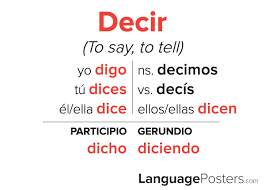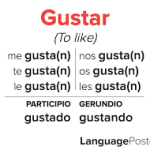If you want to learn how to conjugate the verb ‘decir’ in Spanish, you’re in the right place!
In this article, we’ll show you the regular verb endings for ‘decir’ in different tenses, including the present, preterite, imperfect, future, and present subjunctive.
We’ll also cover the imperative mood and irregular forms of ‘decir’.
Plus, you’ll discover common phrases and expressions using ‘decir’.
Get ready to master conjugating ‘decir’ and expand your Spanish vocabulary!
Regular Verb Endings for ‘Decir
To conjugate the regular verb ‘decir’ in Spanish, you’ll use the second person singular form ‘dices’. This form is used when addressing someone informally or talking directly to one person.
For example, if you want to say ‘you say’ in Spanish, you’d say ‘tú dices’.
It’s important to note that the verb form ‘dices’ is specific to the second person singular and shouldn’t be confused with other forms of the verb ‘decir’. When conjugating ‘decir’ in other persons and tenses, you’ll use different endings. However, for the second person singular, ‘dices’ is the correct form.
Conjugating ‘Decir’ in the Present Tense
Now let’s talk about how to conjugate ‘decir’ in the present tense. As a regular verb, ‘decir’ follows the same pattern as other -ir verbs. However, it’s important to note that ‘decir’ is an irregular verb in the first person singular form, where it changes to ‘digo’.
Keep these regular and irregular forms in mind as we explore the conjugation of ‘decir’ in the present tense.
Regular Verb Forms
Conjugate ‘decir’ in the present tense by using the abstract noun ‘communication’.
When you want to express yourself in Spanish, it’s crucial to understand how to conjugate the verb ‘decir’ (to say or to tell) in the present tense.
To do this, you need to take the stem ‘dec-‘ and add the appropriate endings according to the subject pronoun.
For example, when you say ‘I say’ or ‘I am saying,’ you’d conjugate it as ‘yo digo.’
Similarly, for ‘you say’ or ‘you are saying,’ it becomes ‘tú dices.’ Remember to contract the pronoun ‘tú’ with the verb for smoother speech.
Irregular Verb Forms
Mastering the irregular verb forms of ‘decir’ in the present tense will greatly improve your Spanish communication skills.
Here are some examples of how ‘decir’ changes in different subject pronouns:
- Tú dices: Imagine yourself confidently expressing your thoughts and opinions in Spanish, saying ‘Dices’ with conviction.
- Usted dice: Picture yourself in a formal setting, politely addressing someone and saying ‘Dice’ with respect.
- Nosotros decimos: Envision a group of friends having a lively conversation, each of you contributing your ideas and saying ‘Decimos’ together.
- Ellos dicen: Visualize a group of people discussing a topic passionately, with multiple voices overlapping and saying ‘Dicen’ in unison.
Conjugating ‘Decir’ in the Preterite Tense
To conjugate ‘decir’ in the preterite tense, you’ll use the determiner ‘el’ before the verb. This tense is used to talk about past actions or events that are completed. For example, if you want to say ‘you said,’ you’d say ‘tú dijiste.’ Here, the determiner ‘el’ is contracted with the verb ‘decir’ to form ‘dijiste.’
Similarly, if you want to say ‘they said,’ you’d say ‘ellos dijeron.’ Again, the determiner ‘el’ is contracted with the verb ‘decir’ to form ‘dijeron.’
It’s important to note that ‘decir’ is an irregular verb, so its conjugation in the preterite tense doesn’t follow the regular pattern. By using the correct determiner and conjugating ‘decir’ accordingly, you can accurately express past actions or events in Spanish.
Conjugating ‘Decir’ in the Imperfect Tense
In the imperfect tense, you’d use the compound preposition ‘estabas diciendo’ to express ‘you were saying’ in Spanish. This tense is used to describe ongoing or continuous actions in the past.
Imagine yourself in a cozy café in Spain, sipping on a cup of rich coffee, while chatting with a friend. The atmosphere is filled with the aroma of freshly baked pastries and the sound of soft music playing in the background.
As you sit there, you recall the conversation you were having with your friend. You were sharing stories, laughing, and exchanging ideas. The words flowed effortlessly, creating a sense of connection and warmth.
The imperfect tense captures those moments of uninterrupted dialogue, allowing you to express the idea of ‘you were saying’ in Spanish.
Conjugating ‘Decir’ in the Future Tense
In the future tense, the verb ‘decir’ undergoes some changes in its endings. You’ll notice that the endings for the regular conjugations are the same as in the imperfect tense, but with a different set of verb endings. There are also some irregular forms to be aware of, such as ‘diré’ for ‘I will say’ and ‘dirás’ for ‘you will say’.
Here are a few examples of how ‘decir’ is used in the future tense:
‘Yo diré la verdad’ (I will tell the truth)
‘Tú dirás la respuesta’ (You will say the answer)
‘Ellos dirán su opinión’ (They will say their opinion).
Verb Ending Changes
Change the ending of ‘decir’ to conjugate it in the future tense. To conjugate ‘decir’ in the future tense, simply drop the -ir ending and add the appropriate ending for each pronoun. Here’s how it’s done:
- Yo diré: I’ll say
- Tú dirás: You’ll say
- Él/Ella/Usted dirá: He/She/You (formal) will say
- Nosotros/Nosotras diremos: We’ll say
- Vosotros/Vosotras diréis: You all will say
- Ellos/Ellas/Ustedes dirán: They/You all (formal) will say
Visualize yourself confidently expressing your thoughts and ideas in the future. Imagine yourself saying ‘Yo diré’ with determination. Picture yourself telling someone ‘Tú dirás’ with conviction. Envision a group of friends saying ‘Nosotros diremos’ with excitement. Lastly, see a crowd listening attentively as you say ‘Ellos dirán’ with authority.
Irregular Conjugation Forms
You often hear people say that ‘Decir’ in the future tense is irregular. Well, they’re right! When conjugating ‘decir’ (to say/tell) in the future tense, there are some irregularities that we need to be aware of.
The stem of the verb changes from ‘dir’ to ‘diré’ for the first person singular, ‘dirás’ for the second person singular, ‘dirá’ for the third person singular, ‘diremos’ for the first person plural, ‘diréis’ for the second person plural, and ‘dirán’ for the third person plural.
These changes might seem strange at first, but with practice, you’ll get the hang of it. Just remember to use the correct stem and add the appropriate endings for each pronoun, and you’ll be able to conjugate ‘decir’ in the future tense without any problems.
Examples of Usage
So, how will you use the future tense conjugation of ‘decir’ in your Spanish conversations? Let’s explore some examples to help you understand how to use it effectively:
- Mañana le dirás a tu amiga que la quieres mucho. (Tomorrow, you’ll tell your friend that you love her very much.)
- En el futuro, les diré a mis padres que quiero estudiar medicina. (In the future, I’ll tell my parents that I want to study medicine.)
- ¿Qué les dirás a tus compañeros de trabajo cuando te vayas de la empresa? (What will you tell your colleagues when you leave the company?)
- Nos diréis la verdad sobre lo que ocurrió, ¿verdad? (You will tell us the truth about what happened, right?)
Using the future tense conjugation of ‘decir’ allows you to express future actions or intentions in your conversations. Practice these examples to become more comfortable with this verb tense and enhance your Spanish communication skills.
Conjugating ‘Decir’ in the Conditional Tense
To conjugate ‘decir’ in the conditional tense, you simply add the conditional endings to the stem of the verb. The stem of ‘decir’ is ‘dir’. So, to form the conditional tense, you’d add the conditional endings -ía, -ías, -ía, -íamos, -íais, or -ían to the stem ‘dir’.
For example, if you want to say ‘you would say’ in Spanish, you’d say ‘tú dirías’. Similarly, ‘I would say’ would be ‘yo diría’.
In the conditional tense, ‘decir’ is used to express a possibility or a hypothetical situation. It’s important to note that the conditional tense can also be used to express politeness or requests.
Conjugating ‘Decir’ in the Present Subjunctive Tense
Now let’s talk about conjugating ‘decir’ in the present subjunctive tense.
This tense has irregular conjugation rules, so pay attention.
It’s also commonly used in phrases expressing doubt, possibility, or desire.
Understanding when and how to use this verb tense is essential for effective communication in Spanish.
Irregular Conjugation Rules
You’ll need to know the irregular conjugation rules for ‘decir’ in the present subjunctive tense. Here are some key points to keep in mind:
- Yo (I) form: diga – Imagine yourself confidently stating your opinion.
- Tú (You) form: digas – Picture yourself encouraging someone to speak up.
- Él/Ella/Usted (He/She/You formal) form: diga – Visualize someone politely expressing their thoughts.
- Nosotros/Nosotras (We) form: digamos – Envision a group of friends discussing their plans.
Common Subjunctive Phrases
Learn how to effectively use the present subjunctive tense of ‘decir’ in common phrases to express your thoughts and opinions.
When expressing doubt, uncertainty, or desire, you can use phrases such as:
- ‘Es posible que digas’ (It’s possible that you say)
- ‘Espero que digas’ (I hope that you say)
- ‘No creo que digas’ (I don’t believe that you say)
To give advice or make recommendations, you can use phrases like:
- ‘Te recomiendo que digas’ (I recommend that you say)
- ‘Es mejor que digas’ (It’s better that you say)
- ‘Sería conveniente que digas’ (It would be convenient that you say)
These common subjunctive phrases allow you to express your thoughts and opinions in a polite and indirect manner.
Verb Tense Usage
To conjugate the verb ‘decir’ in the present subjunctive tense, you use the preposition ‘que’ followed by the second person singular form ‘digas’.
This tense is used to express desires, doubts, wishes, and recommendations.
When conjugating ‘decir’ in the present subjunctive tense, imagine yourself in these scenarios:
- You’re hoping that someone says the right thing at the meeting.
- You’re advising your friend to speak up and say what they truly feel.
- You’re wishing that your parents tell you the truth about your family history.
- You’re doubting that your partner will say they love you.
Conjugating ‘Decir’ in the Imperative Mood
First, conjugate ‘decir’ in the imperative mood by using the second person singular form ‘di’. In Spanish, when giving commands or instructions, the imperative mood is used.
To conjugate ‘decir’ in the imperative mood, simply drop the final ‘r’ from the infinitive form and add ‘e’ for the singular form. So, ‘di’ is the command form of ‘decir’ when addressing someone informally, like a friend or family member.
For example, if you want to say ‘tell me’, you’d say ‘dime’. It’s important to note that in the imperative mood, pronouns are attached to the end of the verb. So, instead of saying ‘tú di’, you’d say ‘di me’.
The imperative mood is a powerful way to give direct commands in Spanish.
Irregular Forms of ‘Decir
Now let’s explore the irregular forms of ‘decir’ in Spanish. When conjugating this verb, be prepared for a few changes in its stem. Here are some irregular forms to keep in mind:
- Dices: This is the second person singular form of the present indicative. It means ‘you say’ or ‘you are saying’.
- Dirás: This is the second person singular form of the future tense. It means ‘you will say’ or ‘you will be saying’.
- Dije: This is the first person singular form of the preterite tense. It means ‘I said’ or ‘I was saying’.
- Digamos: This is the first person plural form of the present subjunctive. It means ‘let’s say’ or ‘let’s be saying’.
These irregular forms add flavor to the verb ‘decir’ and allow you to express yourself more effectively in Spanish.
Common Phrases and Expressions With ‘Decir
Let’s dive into some common phrases and expressions using ‘decir’ in Spanish.
When someone asks you for directions, you can respond with ‘Dime’ which means ‘Tell me.’
If you want to ask someone to repeat what they said, you can say ‘¿Puedes repetir lo que dijiste?’ which translates to ‘Can you repeat what you said?’
To express disbelief, you can use the phrase ‘¡No me digas!’ which means ‘You don’t say!’
When you want to tell someone to say something, you can use the phrase ‘Di lo que piensas’ which translates to ‘Say what you think.’
Lastly, if you want to say ‘Let’s say’ in Spanish, you can use the phrase ‘Digamos.’
These common phrases and expressions will help you communicate effectively using ‘decir’ in Spanish.
Frequently Asked Questions
What Are Some Common Phrases or Expressions That Include the Verb ‘Decir’?
You’ll want to know some common phrases or expressions that include the verb ‘decir’. They’re used a lot in Spanish. Now let’s see how to conjugate ‘decir’ properly.
How Do You Conjugate ‘Decir’ in the Past Participle Form?
To conjugate ‘decir’ in the past participle form, you use the verb haber. For example, you’ve said would be “has dicho” in Spanish.
Are There Any Irregular Forms of ‘Decir’ in the Present Tense?
Yes, there are irregular forms of ‘decir’ in the present tense. You’ll need to memorize them. But don’t worry, with practice, you’ll become familiar with how to conjugate them correctly. Keep studying!
Can ‘Decir’ Be Used Reflexively? if So, How Do You Conjugate It in the Reflexive Form?
Yes, ‘decir’ can be used reflexively. To conjugate it in the reflexive form, you add ‘se’ to the end of the verb. For example, ‘te dices’ means ‘you say to yourself’.
What Is the Difference Between the Present Subjunctive and the Present Indicative Forms of ‘Decir’?
The difference between the present subjunctive and present indicative forms of ‘decir’ is that the subjunctive expresses doubt, uncertainty, or desire, while the indicative states facts or statements.
Conclusion
In conclusion, conjugating the verb ‘decir’ in Spanish involves using regular verb endings in different tenses such as the present, preterite, imperfect, future, and present subjunctive. Additionally, there are irregular forms of ‘decir’ that need to be memorized.
Learning how to conjugate ‘decir’ is essential for effectively communicating in Spanish, as this verb is commonly used in everyday conversations. By mastering the conjugation of ‘decir’, you’ll be able to express yourself accurately and fluently in Spanish.


